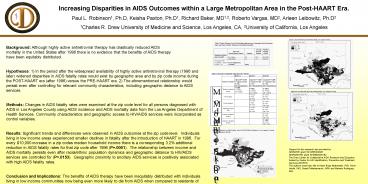Acknowledgments
1 / 1
Title: Acknowledgments
1
Increasing Disparities in AIDS Outcomes within a
Large Metropolitan Area in the Post-HAART
Era. Paul L. Robinson1, Ph.D, Keisha Paxton,
Ph.D1, Richard Baker, MD1,2, Roberto Vargas, MD2,
Arleen Leibowitz, Ph.D2 1Charles R. Drew
University of Medicine and Science, Los Angeles,
CA, 2University of California, Los Angeles
Background Although highly active antiretroviral
therapy has drastically reduced AIDS mortality
in the United States after 1996 there is no
evidence that the benefits of AIDS therapy have
been equitably distributed. Hypotheses 1) In
the period after the widespread availability of
highly active antiretroviral therapy (1996 and
later) widened disparities in AIDS fatality rates
would exist by geographic area and by zip code
income during the POST-HAART era (after 1996)
versus the PRE-HAART era. 2) The aforementioned
relationship would persist even after controlling
for relevant community characteristics, including
geographic distance to AIDS services. Methods
Changes in AIDS fatality rates were examined at
the zip code level for all persons diagnosed with
AIDS in Los Angeles County using AIDS incidence
and AIDS mortality data from the Los Angeles
Department of Health Services. Community
characteristics and geographic access to HIV/AIDS
services were incorporated as control variables.
Results Significant trends and differences
were observed in AIDS outcomes at the zip code
level. Individuals living in low income areas
experienced smaller declines in fatality after
the introduction of HAART in 1996. For every
10,000 increase in a zip codes median household
income there is a corresponding 3.2 additional
reduction in AIDS fatality rates for that zip
code after 1996 (P.0001). The relationship
between income and AIDS mortality persists even
after racial/ethnic population dynamics and
geographic distance to HIV/AIDS services are
controlled for (P.0153). Geographic proximity
to ancillary AIDS services is positively
associated with high AIDS fatality rates.
Conclusion and Implications The benefits of
AIDS therapy have been inequitably distributed
with individuals living in low income communities
now being even more likely to die from AIDS when
compared to residents of more affluent parts of
the metropolitan area. Technological
advancements have, in the case of AIDS outcomes,
widened disparities rather than reduce them.
This occurs despite evidence that Ryan White CARE
Act funding has reached areas where low income
persons living with HIV/AIDS are likely to
reside, calling into question whether the CARE
Act funding has been sufficient, as well as the
efficiency of the programs receiving that
funding.
Model Block One
Model Block Two
Model Bock Three
Support for this research was provided
by NIH/NCRR grant 5G12RR003026 NIH/NCMHHD grant
5P20MD000182 The Drew Center for Collaborative
AIDS Research and Education funded by Center for
HIV Identification, Prevention and Treatment
Services (CHIPTS) The authors would also like to
thank Ricky Bluthenthal, PhD, Kevin Heslin, PhD,
Senait Teklehaimanot, MPH and Melanie Rodriguez,
BSc
- Acknowledgments
- Britt Durham M.D.
- Chat Dang, M.D.
- Eugene Hardin, M.D.































